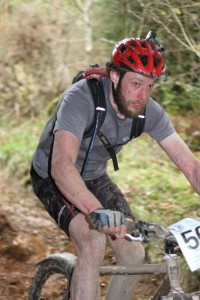
sDNA’s chief developer demonstrating his commitment to active travel (at a mountain bike endurance event!)
Updated May 2016: sorry this post is hopelessly out of date! I have inserted a few extra items into the list below, but for more details on active travel models in sDNA see recent blog posts.
For examples of cycling models see the slides I presented to the Welsh Assembly.
If you’d like somebody else to run models for you please contact one of our partners.
The sDNA team worked hard to enhance our capabilities for active travel modelling. We are working on numerous real-world projects to stay in touch with the needs of practitioners, as well as completing work on health, recreation and community cohesion.
I thought we’d better get all of our information relevant to active transport in one place, so here goes. I’m sorry if this sounds like a sales pitch – but that’s what it is (selling doesn’t come naturally to academics)!
Here is what we offer already:
- The closeness measures in standard sDNA provide information on both the quantity and efficiency of access to facilities, as well as severance and network gravity.
- The betweenness measures in standard sDNA show where flows of pedestrians, cyclists and cars are likely to build.
- The hybrid metric system in sDNA+ allows for modelling routes that trade off multiple characteristics. For example, you can analyze cycling routes that strike a balance between speed, simplicity, hill avoidance and traffic avoidance. The traffic data itself can be generated by a standard sDNA model.
- The hybrid radius and banded radius system allows for more accurate cyclist/pedestrian models simulating the decision to walk/cycle based on accessibility.
- Preset metrics allow quick selection of rules for simulating cyclists, pedestrians, motor vehicles and public transport
- The new statistics tools allow easy and accurate calibration of sDNA models to real data, especially when combined with banded radius from sDNA+.
- The origin and destination weighting system in sDNA+ allows users to incorporate data they already have on homes, jobs and facilities. Alternatively if no such data is available, link weighting can be used as a proxy missing data.
- sDNA+ can output geodesics to assist in evaluation of likely routes by any means the user wishes. For example, all individual simulated pedestrian routes can be examined for exposure to traffic.
- sDNA+ can output predicted users of any given link in the network - especially useful for visualising the effect of new infrastructure.
- sDNA+ can output network buffers even for large scale, country-wide networks.
- sDNA+ operates in full 3d, allowing for the inclusion of terrain contours and multilevel spaces inside buildings such as stations and shopping malls.
- All of the above can be compared before and after a simulated intervention.
sDNA+ is now available to the public as well as our research collaborators. If you are interested please get in touch.
